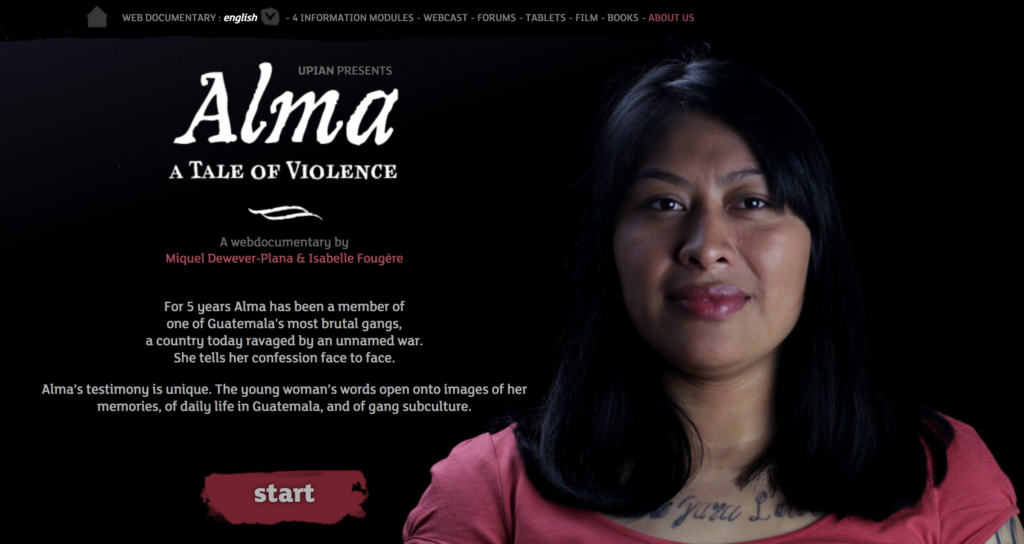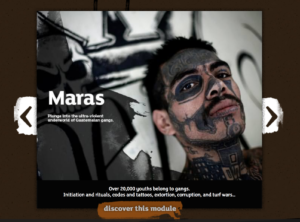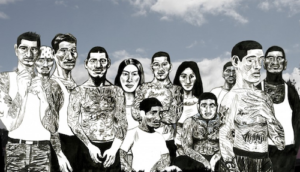
In order to make interactive documentary reviews more focused and systematic, I will use the following outline: platform(s) used, story and structure, user role, navigation directions, navigation execution, and overall comments. Released first in 2011, Alma: A Tale of Violence represents my first application of this approach.
Alma: A Tale of Violence is an interactive documentary available online, on the iPad, and on Android. One of the earlier of the next generation of interactive documentaries, it tells the story of Alma, who joined a Guatemalan gang as a teen and managed to leave with her life as an adult. This review focuses on the web and iPad versions.
The primary story in Alma: A Tale of Violence belongs to Alma herself. In an almost 40-minute video interview, Alma recounts her childhood, gang initiation, gang life, and life thereafter. The interview frames Alma in medium and close-up shots, ensuring our identification with her, though it also offers cutaways to her tattoos and fidgeting hands. Interestingly enough, that framing hides the fact that Alma is now confined to wheelchair.
Alma’s story is harrowing. Alma explains how the gang offered acceptance, belonging, support, and purpose — things unavailable at home.
One price for that belonging, though, is a life of violence. As part of her initiation, Alma helped members kill a woman whom they had just raped. Another part of her initiation involved the choice between her own rape and being beaten. Alma chose the beating because she didn’t want to appear weak.
Another price for that belonging is a lack of freedom. The gang dictated its lower-ranked members’ activities, which often involved collecting protection fees and killing those who refused or couldn’t pay. Alma killed one person for this reason.
Though not explicitly articulated, a third price for that belonging is fear, particularly of the violence turning back on Alma herself. Alma left without permission for two years, and when she returned, she feared the gang’s retribution. This time, none came — they invited her back in. After becoming pregnant and suffering abusive relationships, Alma requested to leave the gang altogether. They beat her briefly, and she left the meeting thinking the situation fine among them. As she walked away, bullets flew. One struck her and left her paralyzed. The bounty still remains on her head.
While this interview plays, a secondary storyline appears above her. The upper “track,” for lack of a better word, offers a combination of still images, B-roll, archival images, sketches, and animations. Sometimes, the upper track offers a thematic connection to Alma’s recollections, such as the pictures of poor neighborhoods. Other times, the upper track depicts Alma’s recollections, such as the animated illustrations of her gang initiation or of a gang rape. Though nonetheless disturbing, the animations offer ways to show the violence without spectacle.

The integration of user, navigation, and narrative ensures a cohesive interactive documentary experience. Casting the user in a role helps with this integration. Alma, though, offers no particular role for its users. The directions only tell users how to access the content, which amounts mostly to swiping on the tablet or moving up and down with a mouse and to tapping or clicking on these respective devices.
The navigation in Alma is straightforward and largely similar between the web and iPad versions. The interview with Alma herself allows the expected starting and stopping of the video, as well as scrolling up to see the upper track and scrolling down to see Alma again. Users can choose not to switch between tracks as well. But, other than the up and down, start and pause, no other interactive features appear in the video.
The modules offer even fewer interactive features. An internal table of contents allows skipping through the modules’ information, or users can progress through each one sequentially, slide by slide, with a click or a tap.
While the navigation’s simplicity allows for easy access to all parts of this interactive documentary, its simplicity undermines the interactive documentary’s cohesiveness. The narrative disconnection between the video interview and the information modules also fails to help create a sense of unity. Overall, the interactive options here remain quite limited.

Another thing I appreciated was the background information’s separation from Alma’s narrative. Balancing oral storytelling and factual details provides a difficult line to walk, with the facts often interrupting the flow of more personal details. The separation ensures a smoothness to Alma’s extended interview that might not be there otherwise.